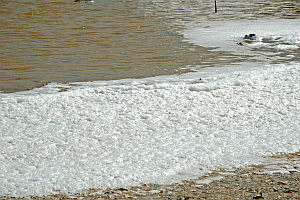|
Minutes from the 2021 LFPOA board, election of officers and district representatives.
Lake Management Co. has announced the lake-wide Fluridone weed treatment is rescheduled for Tuesday, May 26, 2020. This will be a lake-wide application to combat hybrid Eurasian water milfoil.
Treatments have been delayed because of this spring’s cool weather. The lake needs a strong thermocline for maximum treatment benefit. This means the top 10 to 20 feet of water must be warmer than the layer below it. The thermocline keeps the treatment product in a spot where it can do the most good in ridding the lake of Eurasian milfoil. The lake will be posted with flyers like the one below around the lake. You should take normal precautions with a 1-day swimming ban and 3-day watering ban as described.  Foam is a naturally-occurring phenomena on any lake. The Department of Environmental Quality often receives complaints claiming that “someone discharged laundry detergents into the lake” or that there are suds on the river or stream. This phenomenon is often the result of natural processes, not environmental pollution. Foam can be formed when the physical characteristics of the water are altered by the presence of organic materials in the water. The foam that appears along lakeshores is most often the result of the natural die-off of aquatic plants. Plants are made up of organic material, including oils (i.e., corn oil and vegetable oil). When the plants die and decompose, the oils contained in the plant cells are released and float to the surface. Once the oils reach the lake surface, wind and wave action pushes them to the shore. The concentration of the oil changes the physical nature of the water, making foam formation easier. The turbulence and wave action at the beach introduces air into the organically enriched water, which forms the bubbles. Foam commonly occurs in waters with high organic content such as productive lakes, bog lakes, and in streams that originate from bog lakes, wetlands, or woody areas. Oftentimes, streams that originate from woody areas will have a brown tint in the water. The brown tint is often caused by the presence of tannin, which is a substance that gives wood its brown color. The tannin is released during the decomposition of wood along with other materials that cause foaming when they are introduced in water. It is quite common to find foam in dark-colored streams, especially during late fall and winter, when plant materials are decomposing in the water. Some foam in water can indicate pollution. When deciding if the foam is natural or caused by pollution, consider the following:
If you find pollution and believe it is human-induced, please report it to the State of Michigan’s Pollution Emergency Alerting System (PEAS) hotline at 1-800-292-4706. For more information please contact any Water Bureau district office or call the State of Michigan’s Environmental Assistance Center at 1-800-662-9278. |
|||||||

